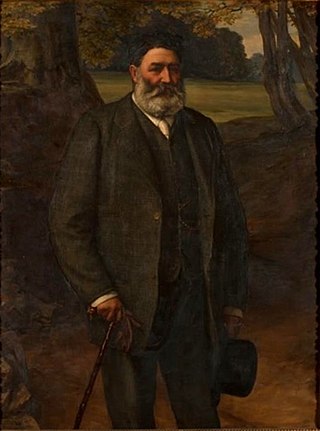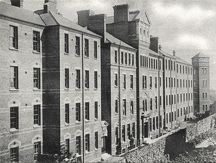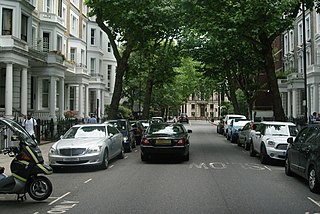
Kensington is an area of London in the Royal Borough of Kensington and Chelsea, around 2.9 miles (4.6 km) west of Central London.

The Royal Borough of Kensington and Chelsea is an Inner London borough with royal status. It is the smallest borough in London and the second smallest district in England; it is one of the most densely populated administrative regions in the United Kingdom. It includes affluent areas such as Notting Hill, Kensington, South Kensington, Chelsea, and Knightsbridge.

Sir George Gilbert Scott, largely known as Sir Gilbert Scott, was a prolific English Gothic Revival architect, chiefly associated with the design, building and renovation of churches and cathedrals, although he started his career as a leading designer of workhouses. Over 800 buildings were designed or altered by him.

Coventry, a city in the West Midlands, England, grew to become one of the most important cities in England during the Middle Ages due to its booming cloth and textiles trade. The city was noted for its part in the English Civil War, and later became an important industrial city during the 19th and 20th centuries, becoming the centre of the British bicycle and later motor industry. The devastating Blitz in 1940 destroyed much of the city centre, and saw its rebuilding during the 1950s and 60s. The motor industry slumped during the 1970s and 80s, and Coventry saw high unemployment. However, in the new millennium the city, along with many others saw significant urban renaissance and in 2017 it was announced that the city had been awarded the title of 2021 UK City of Culture.

Henry Thynne Lascelles, 4th Earl of Harewood, was a British peer and the son of Henry Lascelles, 3rd Earl of Harewood.
West Kensington, formerly North End, is an area in the ancient parish of Fulham, in the London Borough of Hammersmith and Fulham, England, 3.4 miles (5.5 km) west of Charing Cross. It covers most of the London postal area of W14, including the area around Barons Court tube station, and is defined as the area between Lillie Road and Hammersmith Road to the west, Fulham Palace Road to the south, Hammersmith to the north and West Brompton and Earl's Court to the east. The area is bisected by the major London artery the A4, locally known as the Talgarth Road. Its main local thoroughfare is the North End Road.

North Middlesex University Hospital, known locally as North Mid, is a district general hospital in Edmonton in the London Borough of Enfield. The hospital is managed by North Middlesex University Hospital NHS Trust.

Chelsea and Westminster Hospital is a 430-bed teaching hospital located in Chelsea, London. The hospital has a rich history in that it serves as the new site for the Westminster Hospital. It is operated by Chelsea and Westminster Hospital NHS Foundation Trust, and became a member of Imperial College Academic Health Science Centre in July 2020. The hospital is the central part of Imperial College London Chelsea and Westminster Campus, and plays an integral role in teaching students and medical research at Imperial College London.

St Olave's Hospital was a general hospital serving the Rotherhithe area of London until its closure in 1985.

St Mary Abbots is a church located on Kensington High Street and the corner of Kensington Church Street in London W8.

The Cleveland Street Workhouse is a Georgian property in Cleveland Street, Marylebone, built between 1775 and 1778 for the care of the sick and poor of the parish of St Paul Covent Garden under the Old Poor Law. From 1836, it became the workhouse of the Strand Union of parishes. The building remained in operation until 2005 after witnessing the complex evolution of the healthcare system in England. After functioning as a workhouse, the building became a workhouse infirmary before being acquired by the Middlesex Hospital and finally falling under the NHS. In the last century it was known as the Middlesex Hospital Annexe and the Outpatient Department. It closed to the public in 2005 and it has since been vacated. On 14 March 2011 the entire building became Grade II Listed. Development of the site began in 2019 by current owner University College London Hospitals (UCLH) Charity as a mixed-use development including residential, commercial and open space, but construction has been held up by the necessity to remove human remains stemming from the use of the area around the workhouse as a parish burial ground between 1780 and 1853. There has also been controversy about the amount of social housing to be included in the development.

John Giles was a British architect. He was born in Lincoln, probably in 1830, and his family came from Branston near Lincoln. He was articled to the Lincoln architect Pearson Bellamy. He had moved to London by 1859 and with Pearson Bellamy entered a number competitions for major public buildings. Of these only one, for Grimsby Town, was successful. In London he was responsible for a number of major projects including the Langham Hotel. He also started in 1869 on the design of hospitals with the Infirmary to Hampstead Union Workhouse. After a short period of partnership with Lewis Angel, when Stratford Town Hall was built and with Edward Biven, by 1873 he was in partnership with Albert Edward Gough. They were joined in the practice by J E Trollope and they became involved in the design of Arts and Crafts housing in London's west end. Giles had business interests in the City of London and was noted in 1867 as being a Director of the Imperial Guardian Life Insurance Company.

St Alfege's Hospital was a hospital that operated in the Maze Hill area of east Greenwich in southeast London. It operated as the Greenwich Union Infirmary from 1874 to 1929. It was briefly known as the Greenwich and Deptford Hospital before becoming St Alfege's Hospital in 1931. It was then superseded by Greenwich District Hospital in 1968.
St James' Hospital was a healthcare facility in Balham, London that existed between 1910 and 1988. The hospital buildings occupied sites within the boundary of Ouseley Road, Sarsfield Road and St James's Drive Balham London SW12.

Paddington General Hospital was a health facility in Harrow Road, Paddington, London.
Fulham Hospital was an English hospital in the west London district of Fulham from 1884 to 1973. From 1957 onwards it was merged with the Charing Cross Hospital and was gradually demolished. Charing Cross Hospital relocated from central London and now occupies the former Fulham Hospital site, south of St Dunstan's Road.

Dulwich Community Hospital was a hospital located in Dulwich, in South London.

Marloes Road is a street in the Kensington area of London, England. It runs roughly south to north, from a T-junction with Cromwell Road to Cheniston Gardens and Abingdon Villas. It has junctions with Lexham Gardens, Stratford Road and Scarsdale Villas.

The Heavitree Hospital (currently branded as the Royal Devon and Exeter Hospital (Heavitree)) is a hospital currently operated by the Royal Devon University Healthcare NHS Foundation Trust, as a satellite site of the Royal Devon and Exeter Hospital with its main site a short distance away at Wonford. The hospital started as the Exeter Workhouse, and was also known as the Exeter City Hospital.

Kensington Green is a private gated-community on eight acres of land off Marloes Road in Kensington, London, on the site of what was St Mary Abbots Hospital.


















